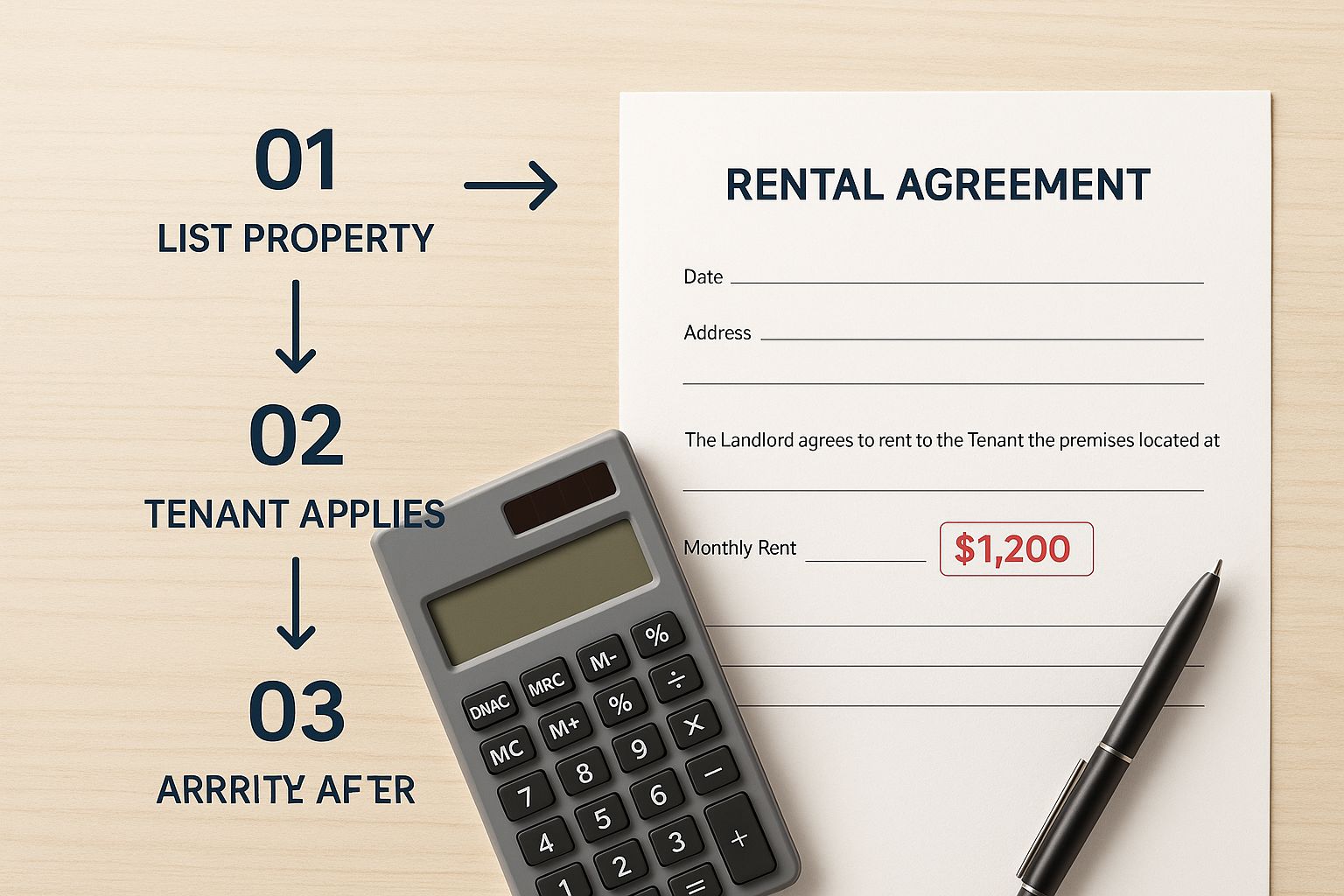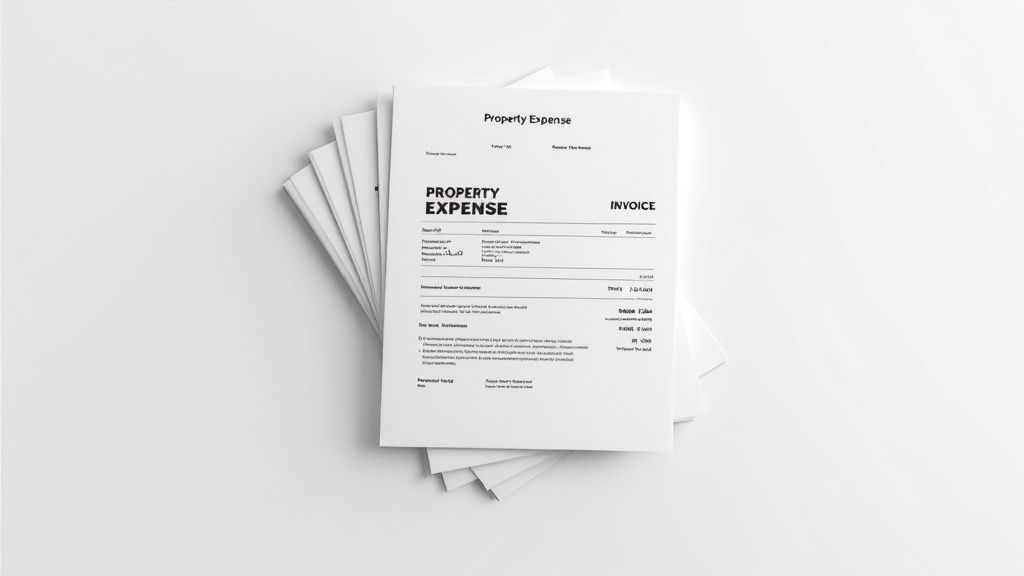At its core, rental property cash flow is the money left in your bank account each month after you’ve collected rent and paid all the bills. It’s the simplest, most honest measure of how profitable your investment really is—your property’s take-home pay.
Mastering it is the difference between owning a hobby and running a wealth-building business.
Why Cash Flow is the Heartbeat of Your Investment
Picture your rental property as a small business. Your total revenue is the rent you collect plus any extra income like pet or parking fees. Your operating expenses are all the costs to keep it running—mortgage, taxes, insurance, management fees, and funds for repairs and vacancies.
What’s left after every single bill is paid? That’s your cash flow.
A strong, positive cash flow is the engine that drives your wealth forward. While hoping for property appreciation is a great long-term strategy, consistent monthly cash flow is what gives you immediate income and financial stability. It's what makes real estate such a powerful asset right now.
Why an Actionable Cash Flow Strategy Matters Now
Focusing on cash flow isn't just a conservative strategy; it’s a battle-tested method for building wealth that lasts. It's a game plan that has proven incredibly resilient through economic curveballs, solidifying rental properties as a go-to for stable income.
Just look at the numbers. Top U.S. markets for cash flow, like Birmingham, Memphis, and Cleveland, offer rental yields that blow national averages out of the water. This proves that incredible opportunities exist far beyond the high-priced coastal cities known for appreciation. With the current housing shortage and rising inflation, a steady rental income is one of the most dependable hedges against market uncertainty you can find. You can learn more about the best rental property markets for investors on RentalIncomeAdvisors.com.
Ultimately, mastering your financial future in real estate starts with getting brutally honest about the two sides of this equation: every dollar coming in and every dollar going out. Get this right, and you’re on your way to making much smarter investment decisions.
How to Accurately Calculate Your Cash Flow
To get a real handle on your investment's health, you have to move beyond napkin math and get precise with your cash flow calculation. This isn't just about subtracting the mortgage from the rent. It’s a deep dive into every single dollar coming in and every dollar going out.
Think of it as creating a financial blueprint for your property. When you master this calculation, you gain the power to confidently size up any potential deal and squeeze maximum profit out of your current portfolio.
Let's break it down into actionable steps.
Step 1: Tally Your Total Income
First, account for every dime your property brings in. Monthly rent is the main event, but don't overlook smaller income streams that add up.
Create a checklist for every property:
- Monthly Rent: The core income from your tenants.
- Pet Fees: Extra monthly charges or one-time fees for pets.
- Parking Fees: Income from assigned spots, carports, or garages.
- Laundry Income: Money from coin-operated washers and dryers.
- Late Fees: Charges collected when rent isn't paid on time.
Add all of these up to get your Gross Operating Income (GOI). This is the starting line—the absolute maximum income your property could generate before a single bill gets paid.
Step 2: Build a Complete Expense Profile
Next is the expense side of the ledger. This is where many new investors trip up, badly underestimating the true cost of owning a rental. A painfully thorough expense list is non-negotiable for an accurate analysis.
This infographic hits on the key steps for figuring out your rental's real financial performance.

As the visual shows, a precise calculation means looking past just the mortgage payment and digging into all the operational costs that eat into your revenue.
Your expenses generally fall into a few key buckets:
- Mortgage Payment: This is your PITI (principal, interest, taxes, and insurance).
- Property Management Fees: Usually runs 8-12% of the monthly rent. Even if you self-manage, account for the value of your time.
- Repairs and Maintenance: Budget for inevitable fixes. A good rule of thumb is 5-10% of your GOI.
- Vacancy Reserves: Set money aside for when the unit is empty. Plan on 5-10% of GOI for this.
- Capital Expenditures (CapEx): This is your savings account for big-ticket items—a new roof, HVAC system, or water heater. Earmark another 5-10% of GOI here.
Once you subtract all your operating expenses from your Gross Operating Income, you're left with your Net Operating Income (NOI). NOI is a pure measure of a property's profitability before you factor in the mortgage. The final step? Subtract your mortgage payment from the NOI to find your true monthly cash flow.
Sample Rental Property Cash Flow Calculation
To make this crystal clear, let's walk through a quick example. Here’s a breakdown of the income and expenses for a hypothetical rental property, showing the formula in action.
| Item | Monthly Amount | Calculation Notes |
|---|---|---|
| Gross Operating Income (GOI) | $2,100 | ($2,000 Rent + $100 Pet Fees) |
| Property Management (10%) | -$210 | 10% of GOI |
| Vacancy Reserve (5%) | -$105 | 5% of GOI |
| Repairs & Maintenance (5%) | -$105 | 5% of GOI |
| Capital Expenditures (5%) | -$105 | 5% of GOI |
| Total Operating Expenses | -$525 | Sum of all non-debt expenses |
| Net Operating Income (NOI) | $1,575 | (GOI - Operating Expenses) |
| Mortgage Payment (PITI) | -$1,250 | Principal, Interest, Taxes, Insurance |
| Monthly Cash Flow | $325 | (NOI - Mortgage) |
As you can see, the final $325 per month in positive cash flow is only clear after accounting for all the expenses, not just the mortgage. This is the number that tells you the true health of your investment.
For anyone who wants to go deeper into the numbers behind smart investing, our guide on essential real estate math formulas is a fantastic resource. It covers other key metrics that, when used with your cash flow analysis, give you a bulletproof overview of any deal.
The Hidden Factors That Shape Your Profits

Running the numbers is a crucial first step, but even the most detailed spreadsheet can't tell the whole story. The real-world rental property cash flow of a deal is shaped by powerful forces that don't always show up on a balance sheet.
These are the drivers that can turn a decent deal into a home run—or transform a seemingly profitable property into a money pit.
Think of these factors like a weather forecast before a long voyage. Ignoring them is a gamble. Understanding them helps you navigate the market, avoid storms, and chart a course toward predictable profits. Three areas demand your focus: market dynamics, property-specific details, and your financing structure.
The Power of Location and Market Trends
The old real estate mantra—location, location, location—is really just a simpler way of talking about cash flow. A strong local economy with steady job growth means more people have the income to rent, which keeps demand high and your units full.
Population trends are just as critical. Cities that are growing need more housing, plain and simple. This dynamic naturally pushes rents up and keeps vacancy rates low, which is exactly what you want as a landlord.
But it’s not just about the city; the immediate neighborhood is what tenants really care about. Pay close attention to:
- School District Ratings: Great schools are a magnet for families, who often make for stable, long-term tenants.
- Proximity to Amenities: Being close to parks, grocery stores, and public transit makes a rental far more desirable.
- Neighborhood Safety: Low crime rates are non-negotiable for most renters and a top driver of tenant quality.
Zooming out, a massive global housing shortage is creating a powerful tailwind for rental demand. As of 2025, there's a net shortage of about 6.5 million housing units across key developed economies. This has kicked off a worldwide affordability crisis, pushing more and more households into the rental market.
In fact, over 80% of households in these markets live where renting is becoming more common than buying. For investors, this trend points toward stronger occupancy and sustained rental income growth.
Property-Specific Details Matter
Not all houses in a great market are created equal. The physical characteristics of your property will have a direct impact on both how much rent you can charge and how much you’ll spend to keep it running.
An older home might have a certain charm, but it could also come with a hidden price tag of frequent and expensive repairs. On the flip side, a modern unit with an open layout and updated appliances can command a premium rent and attract better-qualified tenants, leading to less turnover.
The age, condition, and layout of a property are what determine your maintenance budget and its appeal to renters. These variables are a huge piece of the puzzle, as they directly influence the cost of holding a property year after year.
How Your Financing Shapes Cash Flow
Last but certainly not least, the way you finance the deal is often the single biggest lever you can pull to influence your monthly cash flow. Your mortgage payment is a large, fixed expense that eats directly into your gross income, making your loan terms absolutely critical.
A lower interest rate means a smaller monthly payment and more cash left over for you. The amortization period—how long you have to pay the loan back—also plays a huge role.
A 30-year loan will have a much lower monthly payment than a 15-year loan on the same property. While you'll pay more in total interest over the long haul, the 30-year option creates better immediate cash flow. By carefully weighing all these factors, you can see beyond the simple math and start making smarter, more durable investment decisions.
6 Proven Strategies to Increase Your Cash Flow
Once your rental is up and running, the game shifts from finding a deal to optimizing its performance. Maximizing your rental property cash flow is an ongoing process of finding ways to widen the gap between what you earn and what you spend.
This process boils down to two pillars: actively increasing income and diligently shrinking expenses. Here are six actionable strategies you can implement.
Income-Boosting Strategies
- Execute Strategic Renovations: You don't need a full gut job. Target high-impact areas like kitchens and bathrooms to command significantly higher rent. A simple refresh with new paint, modern light fixtures, and updated cabinet hardware can offer a fantastic return.
- Add In-Demand Amenities: Think about what tenants in your market truly want. Installing an in-unit washer and dryer is a classic winner. Adding a dishwasher or creating a small, fenced-in yard space can make your property stand out from the competition.
- Monetize Extra Services: Look for untapped opportunities. This could mean adding coin-operated laundry, charging monthly pet fees, or renting out an unused garage or storage shed to tenants who need more space.
A key part of this is something investors call "forced appreciation"—where you actively increase a property's value through your own improvements. This is the engine behind powerful strategies that focus on buying, renovating, and then refinancing to pull your capital right back out for the next deal.
These upgrades are a perfect fit for a specific real estate strategy designed for rapid portfolio growth. You can dive deep into this powerful approach in our guide to the BRRRR method in real estate.
Expense-Slashing Strategies
- Challenge Your Property Taxes: Tax assessments aren't set in stone. If you believe your property is over-assessed compared to similar homes, you can file an appeal. The paperwork is worth it for a permanently lower annual tax bill.
- Refinance Your Mortgage: This is one of the biggest levers you can pull. If interest rates have dropped since you bought the property, refinancing could slash your monthly payment and give your cash flow an immediate, substantial boost.
- Implement Preventative Maintenance: Don't wait for a tenant's panicked 2 a.m. call. A regular maintenance schedule—like getting the HVAC system serviced annually and cleaning the gutters each fall—helps you avoid expensive emergency repairs. A small investment now prevents a much larger, budget-wrecking expense later.
Costly Mistakes That Erode Your Cash Flow

Maximizing your rental property cash flow is just as much about plugging leaks in your financial boat as it is about scooping more water in. I've seen countless investors with what looks like a great deal on paper end up with a financial nightmare because they stumbled into a few common, and entirely predictable, traps.
Learning to spot these landmines before you step on them is one of the most critical skills you'll ever develop. It’s the real difference between building a portfolio that generates reliable monthly income and owning a property that just drains your bank account.
Underestimating Maintenance and Capital Expenditures
One of the quickest ways to kill your returns is to treat maintenance and capital expenditures (CapEx) like an afterthought. It's a classic rookie mistake. New investors get laser-focused on the mortgage payment and totally forget that every single property—no matter how new or shiny—is in a constant state of decay. Things break.
Failing to budget for this reality is a recipe for disaster. A water heater doesn't care about your financial goals when it decides to burst, and a leaking roof won't wait until you've saved up. Without a dedicated fund for these big-ticket items, a single emergency repair can instantly wipe out years of positive cash flow.
Actionable Tip: Treat your maintenance and CapEx reserves as a non-negotiable monthly bill. Automatically set aside 5-10% of your gross rental income for each of these categories. This isn't just planning; it's financial self-defense that ensures you have cash on hand when a major system inevitably fails.
Overlooking Vacancy and Poor Tenant Screening
An empty rental is a cash flow killer. Period. Every single month your property sits vacant, you're still on the hook for the mortgage, taxes, insurance, and utilities. Yet, so many financial projections are built on the fantasy of 100% occupancy, which almost never happens in the real world.
This mistake is often made worse by lazy tenant screening. When landlords get desperate to fill a vacancy, they lower their standards. This kicks off a destructive cycle of late payments, property damage, and expensive evictions. A single bad tenant can easily cost you more in legal fees and lost rent than a few extra weeks of vacancy ever would have.
Here's your action plan:
- Thorough Background Checks: Don't skip steps. Always verify income, run a credit report, and check for any eviction history.
- Realistic Vacancy Budget: A good rule of thumb is to set aside at least 5% of your gross annual rent to cover the inevitable gaps between tenants.
- Focus on Tenant Retention: Finding a new tenant is expensive. Keeping a good, long-term tenant is one of the most profitable things you can do.
The Pitfalls of Inefficient Property Management
Finally, a ton of investors try to self-manage their properties to "save money" but lack the time, expertise, or systems to do it right. This path often leads straight to burnout and costly mistakes, from violating local landlord-tenant laws to fumbling simple maintenance requests and angering good tenants.
While professional property management isn't free—it typically costs 8-12% of the monthly rent—a great manager often saves you more than their fee. They do this through better tenant screening, achieving lower vacancy rates, and giving you access to their network of vetted, affordable contractors.
Whether you hire a pro or do it yourself, having an efficient, repeatable system is non-negotiable. It’s the only way to protect both your time and your cash flow.
Staying Ahead: Future Trends in Real Estate Investing
Great investors don't just master today's market—they're already looking at the major shifts that will define tomorrow. The landscape for rental property cash flow is constantly being redrawn by powerful economic and social currents. Spotting these trends early is what separates the pros from the pack.
One of the biggest game-changers is the explosion of remote work. Millions of professionals are no longer tethered to expensive downtown cores, and they're taking their rental dollars with them. This great migration is fueling incredible demand in suburban and secondary markets that were, until recently, completely off the radar for many investors.
Economic Headwinds and Market Realities
Of course, it's not all smooth sailing. We're all feeling the squeeze from inflation and unpredictable interest rates. Inflation jacks up your operating costs—everything from a bucket of paint to your annual property tax bill costs more. At the same time, higher interest rates make financing more expensive, putting direct pressure on your monthly cash flow.
But here’s the other side of the coin: a deep, persistent housing shortage in many of the most desirable markets. This simple imbalance of supply and demand acts as a powerful support for rental income, often helping to balance out those rising costs.
Globally, this dynamic of tight supply and strong tenant demand is the primary engine driving rental property cash flow, especially in top-tier real estate markets. It’s this scarcity that gives landlords pricing power and keeps net operating incomes healthy.
Even with central banks around the world tightening their belts, vacancy rates for quality properties in major global markets are hovering near historic lows. For example, in early 2025, markets like the UK saw property values creep up, largely because rising rents and fierce demand showed that rental income is still a rock-solid component of returns, even in an uncertain economy. You can get a deeper dive into this from the global real estate outlook on mandg.com.
By keeping a close eye on these bigger picture trends—from the work-from-home revolution to global supply issues—you can position your portfolio to not just weather the storms, but to actively capitalize on the next wave of cash flow opportunities.
Answering Your Top Questions About Rental Cash Flow
When you're starting out, a few key questions always pop up about rental property cash flow. Getting these concepts straight is what separates the investors who move forward with confidence from those who stay stuck in analysis paralysis.
What’s a Good Cash Flow Number to Aim For?
The classic benchmark you’ll hear tossed around is $100 to $200 per month, per door, after every single expense has been paid. It’s a solid target.
But here's the reality: it's not a one-size-fits-all rule. An investor might knowingly accept lower—or even zero—cash flow on a property in a red-hot market where they’re banking on rapid appreciation to deliver their big payday. It all comes down to your personal strategy.
How is Cash Flow Different From ROI?
Think of it this way: cash flow is the actual, physical money that hits your bank account each month. It’s the profit you can see and spend.
Return on Investment (ROI) and Cash-on-Cash Return, on the other hand, are percentages. They’re performance metrics that tell you how hard your invested money is working for you, comparing your annual cash flow to the total cash you put into the deal. Cash flow is the fuel; ROI is the fuel efficiency rating.
Can Negative Cash Flow Ever Be a Good Thing?
It sounds crazy, but yes—in very specific situations. This is an advanced, high-risk strategy, so tread carefully.
An experienced investor might intentionally buy a property that loses a little money each month if they have rock-solid data showing the neighborhood is about to explode in value. They're betting that the massive appreciation will more than cover the small monthly losses. It’s a speculative play, not a foundational income strategy.
Ready to stop guessing and start analyzing properties with precision? Flip Smart provides instant valuations, rehab cost estimates, and accurate cash flow projections in seconds. Analyze your next deal for free at flipsmrt.com.
